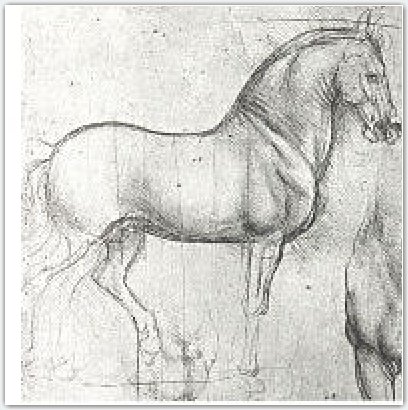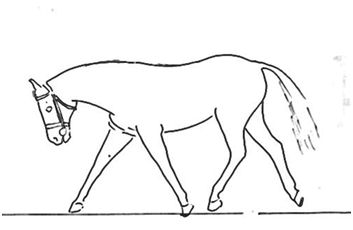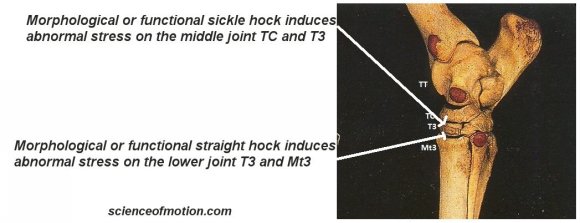Mechanoresponsiveness 17
Mechanoresponsiveness 17
From Leonardo da Vinci to James Rooney
“His work will remain relevant for centuries to come. Much like Leonardo's.” (Eric Schweitzer)

James Rooney was a precursor. He was the first to study and identify the kinematics abnormalities causing pathological changes and therefore lameness. His work opened the door to a new generation of highly efficient therapies. The kinematics abnormality is there first and it is the repetition of abnormal kinematics that causes injury. By correcting the kinematics abnormality, if done early enough, it is possible to prevent pathological changes. Once damages have already altered the integrity of the muscle, ligament, or bone structure, correcting the kinematics abnormality remains the necessary condition for recovery and soundness.
Curiously, both veterinary approaches and therapies furthered their research on the structure but skipped the kinematics abnormalities altering the structure. Hocks are injected, muscles spasm are treated and horses are sent back to work hoping that the kinematics abnormality that caused muscle spasm of abnormal stress on the hock on the first place will no longer inducing abnormal stress on the muscle or the joint. James Rooney used several expressions emphasizing the fact that the kinematics abnormality was there first, “The gait-lesion-gait principle” - “A major cause of lameness is lameness” - “The gait abnormality created by a specific lesion is the gait abnormality that causes the lesion”. Without identifying and correcting the source of the kinematics abnormality, the same muscle spasm or the same hock injury will reoccur.
Like always with pertinent thoughts, Rooney had his share of resistance, the ones who deny knowledge because they don’t want to question what they have elected to believe. In the computer age, we refer to them as, “Keyboard riders”, as quite often, they are better on the key board than on the saddle. Rooney refers to them as the waspish ghosts of teleological thinking. “The waspish ghosts of teleological thinking continuously cloud the picture.” (James Rooney). They cloud the picture because instead of upgrading the teaching of our ancestors in the light of new knowledge, they try integrating new discoveries to old beliefs.
Proper synchronization between flexion and extension of the joints and their inward rotations can be disrupted by many other reasons than touching the lower leg with a whip or a pole without adequate coordination of the upper leg and thoracolumbar spine. The purpose of the series, mechanoresponsiveness is going a little deeper that all the superficial theories promoted in the equestrian world. Superficial theories allow believing in approaches which are in fact damaging the horse. Instead, looking at the mechanism of the equine physique at a slightly deeper level distinguish efficient riding and training techniques.
This silhouette for instance, is the computer outline of a photography illustrating, according to the author, the benefit of long and low work. The horse is working heavily loaded on the forelegs and the front limbs adapt to the load, as it is often the case, shifting the whole stance backward. The problem of such backward shift of the front limbs is that the late stance of the front leg alters proper forward movement of the correspondent hind leg. The horse on the picture adapts to the situation alighting the hind leg earlier. This early alighting places the lower part of the hind limb too far back in relation to the upper leg. This is a situation referred to as “functional straight hock”. Functional straight hock. induces the same abnormal stresses on the joints than morphological straight hock. “A straight-leg horse would be more prone to the Mt3 T3 lesion because the hind limb from the hock down would be too far to the rear, relative to the leg above the hock, during the second half of the step. The mechanics then demands that the pastern elevate too soon.” (James Rooney)
the benefit of long and low work. The horse is working heavily loaded on the forelegs and the front limbs adapt to the load, as it is often the case, shifting the whole stance backward. The problem of such backward shift of the front limbs is that the late stance of the front leg alters proper forward movement of the correspondent hind leg. The horse on the picture adapts to the situation alighting the hind leg earlier. This early alighting places the lower part of the hind limb too far back in relation to the upper leg. This is a situation referred to as “functional straight hock”. Functional straight hock. induces the same abnormal stresses on the joints than morphological straight hock. “A straight-leg horse would be more prone to the Mt3 T3 lesion because the hind limb from the hock down would be too far to the rear, relative to the leg above the hock, during the second half of the step. The mechanics then demands that the pastern elevate too soon.” (James Rooney)
Beside heavy load on the forelegs, there are many training misconceptions that can create early impacts on the hind legs. For instance, lateral bending of the thoracolumbar spine is always coupled with a transversal rotation. The rotation can be proper or inverted. Left lateral bending coupled with a rotation shifting the dorsal spines to the right, (inverted rotation), will place the pelvis transversally rotated and the left hip will be higher. The common limb adaptation to this problem is early impact of the left hind leg subjecting the lower joint of the hock, Mt3 T3, to static friction and consequent arthritis.
While one side of the pelvis is high, the other is low inducing the risk of functional sickle hock on the other limb. A morphological sickle hock is a joint having a closer angle than normal, placing the lower half of the limb more forward in relation to the upper half. The advantage of such conformation is giving the visual impression of greater engagement of the hind leg. The disadvantage of the morphological flaw is exposing the middle joint of the hock, TC,T3 to abnormal stresses. “The pastern would not be elevating as the stifle flexes toward the end of stride and asynchrony between TC and T3 would occur.” (James Rooney)

James Rooney identified the kinematics abnormalities which, repeated over time, cause injuries. The next logical evolution should have been studying the capacity to recreate proper kinematics. Instead, the practical application of veterinary researches focused on the lesion, better diagnosis tool, better drugs. Considering that the main teaching of James Rooney is that the kinematics abnormality is there first, waiting for the lesion to happen and then treating the lesion looks more like a regression than a progress. We furthered James Rooney’s work. We learned how to correct the kinematics abnormality. We learned how to identify and correct the source of the kinematics abnormality causing the lesion, and because we did it, we can explain why equine therapies went toward the lesion instead of the cause of the lesion. It is a total paradigm shift.
“The significant problems we face today cannot be solved at the same level of thinking we were at when we created them.” (Albert Einstein)
It is not the hocks that creates a back problem; it is back problem that causes hock injuries. Leo Jeffcott explained that the biomechanics of the vertebral column formed the basis of all body movements but he also demonstrated that the horse thoracolumbar spine does not stretch, does not swing and does not relax. All riding and training principles based on these beliefs are ill-adapted to actual knowledge. The medical world needs facing the fact that once the lesion is healing, it is not a progressive number of minute hand walking that is going to rehabilitate the horse. It is indeed how the horse walks. Injecting the hock and hoping that returning to the gait abnormality that caused the hock problem on the first place is the practical application of the very famous, “doing the same thing but expecting a different result.” We have created a work in hand technique allowing precisely to create perfect limb or hoof placement. The science of motion in hand technique is unique and totally different from other in hand techniques as it is not about making the horse doing move but instead teaching the horse how to move efficiently and soundly.
Repeating the movement does not educate the body as the horse executes the move protecting whatever muscle imbalance is affecting the horse’s body at the instant of the rider’s demand. By updating riding and training principles to actual knowledge, the science of motion allows creating the body coordination optimally adapted to the athletic demand of the performance. We don’t touch the lower legs; we create the body coordination allowing optimum use of the elastic recoil creating sound and efficient kinematics of the hind and front legs.
James Rooney was happy to realize that his work was applied for the education of superior athletes. He was very helpful in figuring how to correct the kinematics abnormality. He did not know that limbs kinematics could be corrected through specific coordination of the equine thoracolumbar spine. I told him that correcting the horse’s thoracolumbar spine at this level of sophistication was not feasible applying conventional principles of riding. But ironically, it was by adapting principles of riding to his findings that it was possible to refine the capacities of a functional spine as well as recreating proper functioning from a dysfunctional spine.
The application to lameness was the logical next step. The capacity to enhance proper limbs kinematics could be applied to correct abnormal limbs kinematics. Often we receive horses with a long history of lameness and therapies and the conclusion that the treatments and therapies did not work. In fact, treatments and the therapies did what they were supposed to do but the horse was put back to work applying the riding and training techniques that caused the problem on the first place.
Furthering Rooney’s work with advanced understanding of equine biomechanics, allows developing and synchronizing efficiently the horse’s physique for the athletic demand of the performance. The kinematics abnormality can be corrected before pathological changes occur. There always have been and there always will be some Don Quixote selling wind brandishing their lance. Facts remain that inward rotation of the joints exist and acting on one part of the limb without associated kinematics of the upper limb and in relation to the mechanism of the thoracolummbar spine, exposes the joint to abnormal frictions and consequent arthritis. If the horse has the misfortune to be trained this way, there is still hope for the horse as long as this type of training is not applied too long. Correcting the kinematics abnormality can prevent the injury but it also the best therapy restoring soundness when pathological changes have already created damages. Jean Luc Cornille



 twitter
twitter facebook
facebook google
google tumblr
tumblr pinterest
pinterest yahoo
yahoo linkedin
linkedin